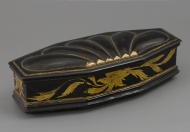Tobacco box in black lacquer with gold
October 2016

Oriental lacquerware was highly fashionable in the seventeenth and eighteenth centuries. Shiny objects with multiple layers of lacquer were typical status symbols for the rich, who wanted to impress their social circles. It is not surprising that this luxury imported from the Far-East was copied in Europe. This tobacco box is a great example of such a replica. The box has the shape of a traditional silver or brass box, but the material and finish are completely different. The material is oak, carved almost as thin as the metal example, including the curved lid that closes the box perfectly and almost airtightly. After the box was carved with much craftsmanship, it was finished with a black paint that strongly resembles the Japanese lacquer. An important difference, however, is the quality of the applied material that was made up of many layers lacquer in Japan. The European variant is only painted, in such thin layers thatit hardly obscures the grain structure of the underlying wood. A gold decoration was then applied over this black paint. Even the inside of the lid was provided with a fashionable representation. That gold decoration has characteristics of the rococo style, so that we can date the box in the third quarter of the eighteenth century. It is still a mystery where this article was made. Certainly a kind of industry has existed, because other wooden objects decorated in a similar way are known. We would nearly forget, that the attractive glossy surface with the playful gold decoration obscures the exceptionally clever method used by the woodworker to cut such a thin and lightweight object.
Amsterdam Pipe Museum APM 22.181
Permalink